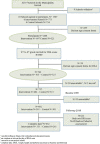Effect of four additional physical education lessons on body composition in children aged 8-13 years--a prospective study during two school years
- PMID: 24131778
- PMCID: PMC3853216
- DOI: 10.1186/1471-2431-13-170
Effect of four additional physical education lessons on body composition in children aged 8-13 years--a prospective study during two school years
Abstract
Background: Strategies for combating increasing childhood obesity is called for. School settings have been pointed out as potentially effective settings for prevention. The objective of this paper was to evaluate the effect of four additional Physical Education (PE) lessons/week in primary schools on body composition and weight status in children aged 8-13.
Methods: Children attending 2nd to 4th grade (n = 632) in 10 public schools, 6 intervention and 4 control schools, participated in this longitudinal study during 2 school years.
Outcome measures: Primary: Body Mass Index (BMI) and Total Body Fat percentage (TBF%) derived from Dual Energy X ray Absorptiometry (DXA). Secondary: the moderating effect of overweight/obesity (OW/OB) and adiposity based on TBF% cut offs for gender.
Results: Intervention effect on BMI and TBF% (BMI: β -0.14, 95% CI: -0.33; 0.04, TBF%: β -0.08, 95% CI:-0.65;0.49) was shown insignificant. However, we found significant beneficial intervention effect on prevalence of OW/OB based on BMI (OR 0.29, 95% CI: 0.11;0.72). The intervention effect on adiposity based on TBF% cut offs was borderline significant (OR 0.64, 95% CI:0. 39; 1.05).
Conclusion: Four additional PE lessons/week at school can significantly improve the prevalence of OW/OB in primary schoolchildren. Mean BMI and TBF% improved in intervention schools, but the difference with controls was not significant. The intervention had a larger effect in children who were OW/OB or adipose at baseline.
Figures
References
-
- Hills AP, Okely AD, Baur LA. Addressing childhood obesity through increased physical activity. Nat Rev Endocrinol. 2010;6(10):543–549. - PubMed
-
- Dobbins M, De Corby K, Robeson P, Husson H, Tirilis D. School-based physical activity programs for promoting physical activity and fitness in children and adolescents aged 6–18. Cochrane Database Syst Rev. 2009;1:CD007651. - PubMed
Publication types
MeSH terms
LinkOut - more resources
Full Text Sources
Other Literature Sources
Medical
Miscellaneous


